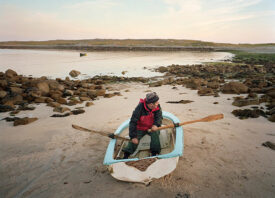Search this site
Inside the Homes of Hermits



When the Russian photographer Natalia Ershova was in school, working on her journalism degree, she fell ill. As a result, she was unable to leave home for two months. To combat the isolation and loneliness, she communicated with friends online. “I often stayed up at night, working on my diploma, and corresponding simultaneously with those in my networks,” she remembers.
It was during this time that she discovered many of her peers were staying at home voluntarily, without going into an office to work every day. One was a young woman she’s known since childhood; another was her husband’s former classmate, and a third studied at the same university as she did. While she had trouble adapting to life at home, she found others prefered it.
“It surprised me that some of them would not want to simply go for a walk in the park or visit the cinema–that they had chosen to stay at home of their own free will,” she says. “As it turned out, communicating via the internet and social media was quite enough for them.” Her surprise turned to curiosity, which in turn turned to understanding, resulting in Journey to the edge of the room, a project examining the emerging culture of people in big cities who prefer to remain mostly homebound.
Ershova believes the lifestyle appeals to people, particularly those in urban centers, because it offers a respite from the stress of constant communication and busy schedules. Everyone she met had a different reason for making the decision, whether it was for convenience or comfort, but they all did so out of choice, rather than necessity, and they were all active on the internet.
Over the course of about a year, she met more and more people who stayed at home, and although it took time, it wasn’t hard to find participants. “I started looking for people through mutual acquaintances,” she says. “One guy turned out to be the brother of my hairdresser, and several people wrote to me themselves after hearing about the project.”
Many of them work remotely in creative fields, including programming, design, photography, and retouching. Some have financial support from family, and, while some might get most of their essentials delivered, they do leave home from time to time. “For example, one girl always goes for paints and brushes herself, once every few months,” the photographer explains. “Another couple goes once a year to a major Anime festival. They spend a long time sewing their costumes, and then they make the trip.”
Some longed to leave the city someday and dreamed of moving to a secluded house in the forest with plenty of space and privacy. Others imagined buying a yacht and living on the water. For most, they remained dreams for now, but in the meantime, an apartment sufficed.
And most were not entirely alone. They have friends and family come to visit, and many live with romantic partners or parents, as housing in Moscow remains expensive. She also met several pets and animal companions. “In one apartment I visited, I was greeted by a cloud of cats–just a cloud!” she remembers. “I could not count them all. I lost count at 21.”
In addition to photographing the people she met, she interviewed them about why they chose to stay at home and how many years they’d led that lifestyle. While she was initially surprised to learn so many people had chosen to spend most of their time at home–sometimes months at a time–Ershova realized that, in many ways, they might represent the direction of our culture in the age of the internet.
She could not have known when she began the project that the global coronavirus pandemic would leave much of the population under stay-at-home orders, but she does understand why it feels so prescient now. “All of my acquaintances and friends transitioned to working from home, and many liked it,” she reflects. “They liked not spending hours on the road and not having to follow office dress codes. I think the future lies in remote work, though it won’t be as extreme as the stay-at-home lifestyle we’re experiencing now–or that the people in my photos prefer.”
Ershova does see the appeal of life at home. There’s a certain freedom that comes with not having places to be and people to see, and she understands that now. Still, she doesn’t think she could ever fully embrace it herself. When restrictions lift, she’ll get back to traveling for work and pleasure, but perhaps the idea of home will have taken on a new layer of meaning.





All images © Natalia Ershova



